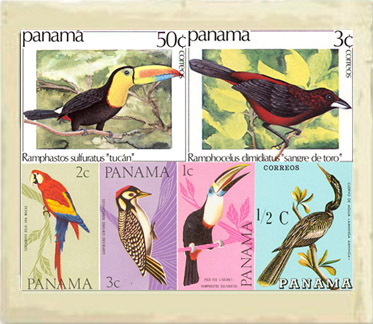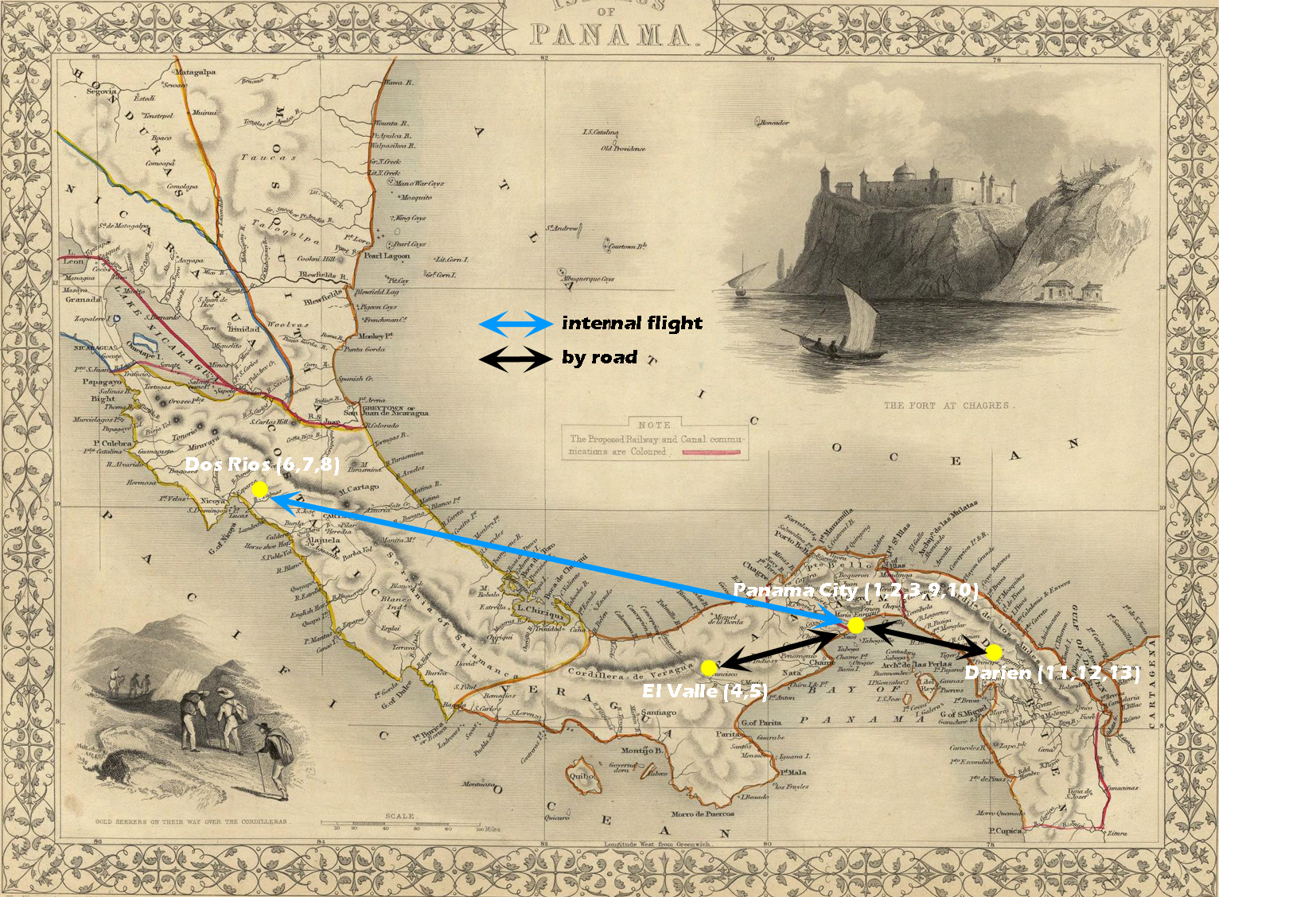
The forest walks start early morning, the program is designed to maximize the number of species and reserves to be seen. However we won’t be in a rush, just to get huge numbers. The walks are at slow pace, this allows for bird and wildlife photography. We visit several private reserves, gardens and feeders where is easier to find many of the key species. The driving and the flights are scheduled during hot hours when the activity is slower. The afternoon plans allow for those who would like to have some rest, to do that at the lodges, at least for half of the program.
 Panama forms the narrowest part of the Mesoamerican Isthmus, which is not only of huge historical importance linking the Atlantic and Pacific Oceans by rail and canal, but also of considerable biogeographical importance as the land bridge between North and South America. The countryis a tropical rain forest with a huge flora and fauna including a surprisingly long bird list of nearly 950 species for you to see! Most birders come in December, January , February, March. In the Chiriqui highlands, Boquete and its surroundings have at least 6 micro climates and so you can always find a dry area to see the birds. December and January can be very wet in the cloud forest, with misty rains called Bajareque. Despite the popularity of these months the best time for birding is the last 2 weeks of April and first two weeks of May when migrants are singing and are in breeding plumage; the birds which stay are singing and nesting and easy to see. It is the southernmost country of Central America.The native flora is simply stunning, and more than 10.000 species have been already identified. With roughly 29% of its territory protected within 15 nature reserves, Panamá is fast becoming a must-see destination for nature travellers the world over. It has a tropical climate and inland its most dominant feature is its central spine of mountains.
Panama forms the narrowest part of the Mesoamerican Isthmus, which is not only of huge historical importance linking the Atlantic and Pacific Oceans by rail and canal, but also of considerable biogeographical importance as the land bridge between North and South America. The countryis a tropical rain forest with a huge flora and fauna including a surprisingly long bird list of nearly 950 species for you to see! Most birders come in December, January , February, March. In the Chiriqui highlands, Boquete and its surroundings have at least 6 micro climates and so you can always find a dry area to see the birds. December and January can be very wet in the cloud forest, with misty rains called Bajareque. Despite the popularity of these months the best time for birding is the last 2 weeks of April and first two weeks of May when migrants are singing and are in breeding plumage; the birds which stay are singing and nesting and easy to see. It is the southernmost country of Central America.The native flora is simply stunning, and more than 10.000 species have been already identified. With roughly 29% of its territory protected within 15 nature reserves, Panamá is fast becoming a must-see destination for nature travellers the world over. It has a tropical climate and inland its most dominant feature is its central spine of mountains.
Day 1: Arrival to Panama City (PTY) – Transfer to the Rainforest (45minutes)
You are met at the airport and driven to the Radisson Summit. The hotel is located a top of hill on the Cruces Trail National Park (Canal Zone), contiguous with the Soberania National Park. The hotel has; Storage Room, Free Wi-Fi, two on-site restaurants, full baths, hot water, laundry service, bar, two outdoor pools, hot breakfast buffet, nature trails, many birds around. Night: Radisson Summit.
Day 2: Pipeline Road
Day of Birding at the famous Pipeline Road and the surrounding areas of the Soberania National Park. Walk the famous Pipeline Road looking for Great Jacamar, Black-tailed Trogon, Pheasant Cuckoo and many other forest birds. Some of the birds easy to photograph include: Slaty-tailed Trogon, Black-breasted Puffbird and Broad-billed Motmot. Admire hummingbird feeders with lowland species such as: Black-throated Mango, White-necked Jacobin, Violet-bellied Hummingbirds, Long-billed Hermit and more. Visit to the ammo-dumps near Gamboa, to look for the Rufescent Tiger-Heronand the White-throated Crake. Afternoon optional visit to the Panama Canal Miraflores Visitor Center. Night: Radisson Summit.
Day 3: Metropolitan Nature Park
With a list of 267 species, the Metropolitan Nature Park is the largest tropical forest park within the limits of a Latin American city, this a good place to find birds of the Pacific forest of the Panama Canal. Some of the key birds are: the Panama endemic: Yellow-green Tyrannulet (National Endemic and rare), Lance-tailed Manakin, and the elusive Rosy-thrush Tanager. After lunch in a local restaurant, we’ll take our ba at Gatun Lake with an important variety of wildlife including Mantled Howler Monkey, White-faced Capuchin monkey, Two-and Three-toed Sloth, reptiles like Green Iguana, Jesus Christ Lizard, River Turtle, Spectacled Caiman and American Crocodile.
Some of the birds are: Snail Kite, Osprey, Keel-billed Toucan, Social Flycatcher, Wattled Jacana, Limpkin.Night: Radisson Summit.
Day 4: Old Gamboa Road & Plantation Road - Drive to El Valle
Explore another hot spot at the Canal corridor, looking for Spectacled Owls and Blue-crowned Motmots. Scan the Summit Ponds for Amazon, Green, Ringed Kingfishers and nesting Boat-billed Herons. Bird walk under the evergreen forest of Plantation Road, there are possibilities to find army ant-swarms and many of the birds that follow these ants, such as Spotted Antbird, and Ocellated Antbird. Some other specialties of the Plantation Road include: Golden-crowned Spadebill, Olivaceous Flatbill, White-whiskered Puffbird and more. The rainforest of the Panama Canal are highly diverse, we go over the list every day! After lunch in a local restaurant, we’ll be driven 1 ½ hour west to El Valle. Night: Anton Valley Hotel
Day 5: EL Valle Foothills
This morning explore the Cerro Gaital and La Mesa area. This area is at higher elevation than the town itself; here look for wet forest species typical of the Western Foothills of Panama such as Tody Motmot, Spectacled Owl, Spot-crowned Barbet, Flame-rumped Tanager, Yellow-eared Toucanet and more. Night: Anton Valley Hotel – EL Valle
Day 6: EL Valle Foothills & Drive to Panama City – Flight to David
Morning Birding El Valle, a picturesque town, located in the crater of an extinct volcano. The town has year-round spring weather thanks to its 700meter altitude. Some other birds are; Silvery-throated Tanager, Orange Bellied Trogon, Blue-throated Toucanet After lunch, afternoon drive to Panama City, to take the flight (45minutes) to David, upon arrival we will be greeted by our excellent driver to be taken to the famous Volcan Town, where we will stay 3 nights to find Highland Birds and many endemics. Night: Hotel Dos Rios
Day 7: Los Quetzales Trail & Volcán Baru National Park
Find Resplendent Quetzals with the help of your specialist guide. The bird could be found eating the wild avocados and everyone will like to have the perfect photo. The Quetzal was the most sacred symbol of the Aztecs and Mayas. The name quetzal is an ancient Indian term for tail feather and the bird itself represents liberty. We should look also for Long-tailed Silky-Flycatcher, Barred Becard, Black-faced Solitaire, Chestnut-capped Brush-Finch, Black-capped Flycatcher, Buffy Tuftedcheek, Ruddy Treerunner Blue-throated (Emerald) Toucanet and more. Continue birding around the area of Cerro Punta looking for more highland birds and endemics. Night: Hotel Dos Rios
Day 8: La Amistad International Park
Visit to La Amistad International Park. This Park also known as PILA, is a World Heritage site and part of the Talamanca Mountain Range, a volcanic origin formation that congregates the highest concentration of endemic and threatened species in Panama, such as Silvery-fronted Tapaculo, Yellow-thighed Finch, Collared Redstart, Flame-throated Warbler, Prong-billed Barbet and Wrenthrush (Zeledonia). Afternoon visit to Cielito Sur, a private reserve with a trail, that winds through hillside forest, passing several streams, providing an opportunity to see some of the highland bird species. Enjoy several sets of hummingbird feeders around the reserve where you can watch the White-throated Mountain Gem, Green Violet-ear, Snowy-bellied Hummingbird, Stripe-tailed Hummingbird, Scintillant Hummingbird, Volcano Hummingbird, Green-crowned Brilliant and more. Night: Hotel Dos Rios
Day 9: Volcán Lakes & Chiriquí Highlands
The lakes near Volcán are very good to find species not found on the higher slopes of Cerro Punta. Wetland species include: Masked Duck and Northern Jacanas. Interesting birds of woodland areas such as Golden-winged Warbler, Olivaceous Piculet, Spotted Woodquail, Pale-breasted Spinetail, Fiery-billed Aracari and Collared Trogon could be found. After lunch, the group we’ll go back to David to take a late afternoon flight to Panama City. Night: Radisson Summit Golf
Day 10 : Darien Lowlands
Depart in mini-bus from Panama City along the Pan-American, stop for morning birding at the Bayano Lowlands, search for Darien specialties such as Rufous-winged Antwren, Black Antshrike, Orange Crowned Oriole, White-eared Conebill and Green-and-Rufous Kingfisher; scan the edge of the Bayano Lake searching for Pied Water-Tyrant and Cocoi Heron, after lunch we’ll continue in route to Torti, afternoon birding in the Torti River, to look for Pacific Antwren and Royal Flycatcher. Night: Torti (Portal Avicar)
Day 11: San Francisco Reserve - Torti
Only 10 minutes from our hotel, this 500 hectares reserve holds many Eastern Panama and Darien specialties. We will be looking for Black-and White Hawk-Eagle, Bare-Crowned Antbird, Barred Puffbird, Spot-breasted Woodpecker, Great Jacamar and more. After lunch we will be driver more deep in to the Darien to keep birding and spend two nights in Meteti (Felicidad Motel)
Day 12: Darien Lowlands – Filo del Tallo Reserve
Morning birding, looking for more Darien specialties such as Golden-headed Manakin, Rufous-winged Antwren, Great Antshrike, Olive-backed Quail-Dove and more. In the afternoon, we will bird near the end of the Pan-American road looking for: Yellow-hooded Blackbird, Paid-water Tyrant, Rufous-tailed Jacamar, and Yellow-breasted Flycatcher etc. Night: Meteti (Felicidad Motel)
Day 13: Darien Lowlands – Yaviza (end of the road)
We'll explore several spots around the village in search of some Darién specialties, such as Black Oropendolas, Bicolored Wren, Gray-cheeked Nunlet, Red-rumped Woodpecker and more. Other typical birds of the zone are Red-throated Caracaras and Laughing Falcons. This Darien area is perfect for those looking to find species from South American origins not found in the rest of Central America. We will plan the transfers out accordingly. Night: Torti (2 hours from airport) or Riande Airport (5 minutes from airport) depending on departure flights (BLD)
Day 14: Departure to Tocumen Airport
Transfer to the Tocumen Airport (PTY) for international flight.